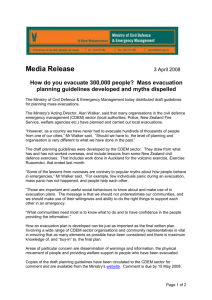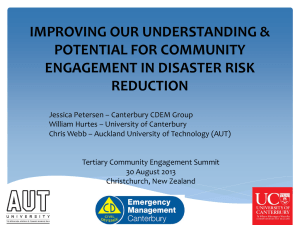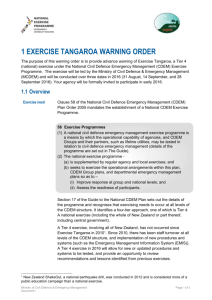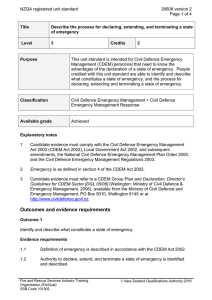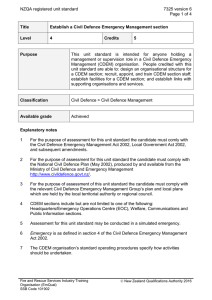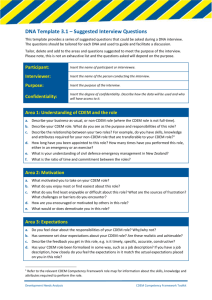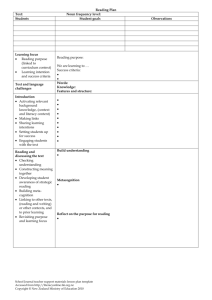background information ( 75kb) - Ministry of Civil Defence and
advertisement
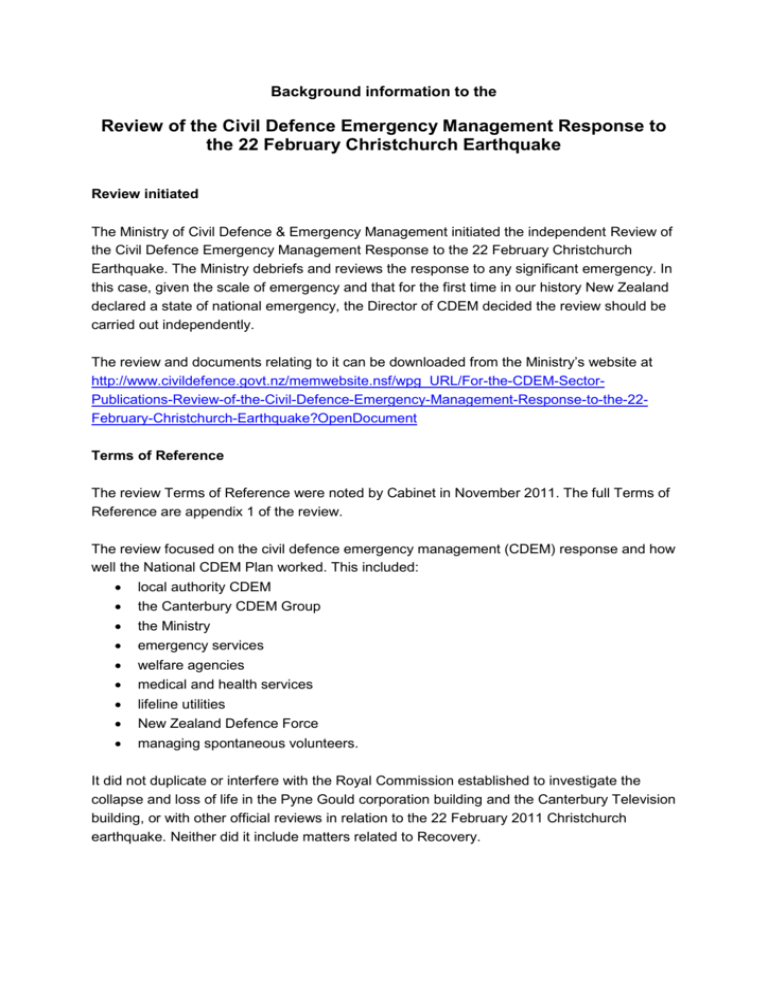
Background information to the Review of the Civil Defence Emergency Management Response to the 22 February Christchurch Earthquake Review initiated The Ministry of Civil Defence & Emergency Management initiated the independent Review of the Civil Defence Emergency Management Response to the 22 February Christchurch Earthquake. The Ministry debriefs and reviews the response to any significant emergency. In this case, given the scale of emergency and that for the first time in our history New Zealand declared a state of national emergency, the Director of CDEM decided the review should be carried out independently. The review and documents relating to it can be downloaded from the Ministry’s website at http://www.civildefence.govt.nz/memwebsite.nsf/wpg_URL/For-the-CDEM-SectorPublications-Review-of-the-Civil-Defence-Emergency-Management-Response-to-the-22February-Christchurch-Earthquake?OpenDocument Terms of Reference The review Terms of Reference were noted by Cabinet in November 2011. The full Terms of Reference are appendix 1 of the review. The review focused on the civil defence emergency management (CDEM) response and how well the National CDEM Plan worked. This included: local authority CDEM the Canterbury CDEM Group the Ministry emergency services welfare agencies medical and health services lifeline utilities New Zealand Defence Force managing spontaneous volunteers. It did not duplicate or interfere with the Royal Commission established to investigate the collapse and loss of life in the Pyne Gould corporation building and the Canterbury Television building, or with other official reviews in relation to the 22 February 2011 Christchurch earthquake. Neither did it include matters related to Recovery. Review team The Ministry contracted Ian Mclean Consultancy Services to carry out the review. The review team was Ian McLean, David Oughton, Stuart Ellis, Basil Wakelin and Claire B.Rubin. Brief CVs of each team member are appendix 2 of the review. Review process Between November 2011 and April 2012 the review team interviewed more than 200 people involved in the response, primarily in Christchurch but also in Wellington and Auckland. Most interviews were face-to-face, with varying numbers of team members. A draft report was provided to the Director of CDEM on 30 April 2012 and the final review on 30 June 2012. The Director forwarded the review to the Minister of Civil Defence for consideration by Cabinet. Recommendations The review made 108 recommendations of which it describes six as its major recommendations. The accompanying media release comments on the recommendations and the actions that will follow from the recommendations. Two of the report’s major recommendations have not been adopted. They were that: Territorial local authorities no longer have power to control the response to emergencies, but that they still retain the power to declare them. The Ministry will, instead, continue to work with the 16 regional CDEM Groups to strengthen, rather than diminish, the role of councils in all aspects of CDEM. The ongoing commitment of councils is crucial to the success of CDEM responses. Most emergencies are short, localised events that are best dealt with at the local level without needing the CDEM Group to formally lead the response. Consideration be given to relocating the Ministry within the Department of Prime Minister and Cabinet so as to provide a better platform for launching responses. The Minister advised Cabinet and Cabinet noted (agreed) that the Ministry will remain within the Department of Internal Affairs and will work to increase other agencies’ awareness of its lead role in a major emergency. The Department of Internal Affairs will continue to provide support services such as information and communications technology, finance, facilities and supplementary staff. After the Christchurch earthquake, the Department quickly reprioritised its resources to give full support to the Ministry and the response. 2 CTV building The Terms of Reference state that the independent review does not duplicate or interfere with the Royal Commission established to investigate the collapse and loss of life in the Pyne Gould Corporation building and the Canterbury TV building. The review describes the actions of the New Zealand Police, the New Zealand Fire Service and other responders as commendable and on many occasions courageous in their response to an event whose magnitude and complexity was in many ways overwhelming. The review also identifies areas for improvement. It commends rescuers' efforts at the CTV building but says they worked under inadequate incident management on the site. It was unclear to the reviewers who was responsible for controlling and co-ordinating operations on the site. However, the position of both the New Zealand Police and New Zealand Fire Service is that the senior Fire Service officer at the site was responsible. The review recommends that a single incident controller be appointed at each significant site. The Ministry is co-ordinating an interagency corrective action plan that will involve Police, Fire Service and other agencies, to consider the report's recommendations and develop adjustments. The report commended all those involved in rescuing those trapped in collapsed buildings for their actions and courage under extreme conditions involving complexity, chaos and uncertainty. Canterbury CDEM Group The review found that, individually, the local authorities that make up the Canterbury CDEM Group functioned well. It also notes that relationships between the councils were poor and they did not work together as a CDEM Group. After the earthquake key changes have been made to the Group’s governance and how it operates. It has been restructured, has new management, many new staff and now has regular formal, and frequent informal, contact with Christchurch City Council. The councils that make up the group are working together on: understanding and reducing risks and hazards training professional development exercises deciding how emergency response and Emergency Operations Centres are managed how public education and information are provided community resilience. 3 Next steps The report makes 108 recommendations that would involve work across different central and local government agencies. The Ministry will coordinate an interagency corrective action plan for work programmes over the next two years. It will report back to the Cabinet Committee for Canterbury Earthquake Recovery with the corrective action plan in November. 4
